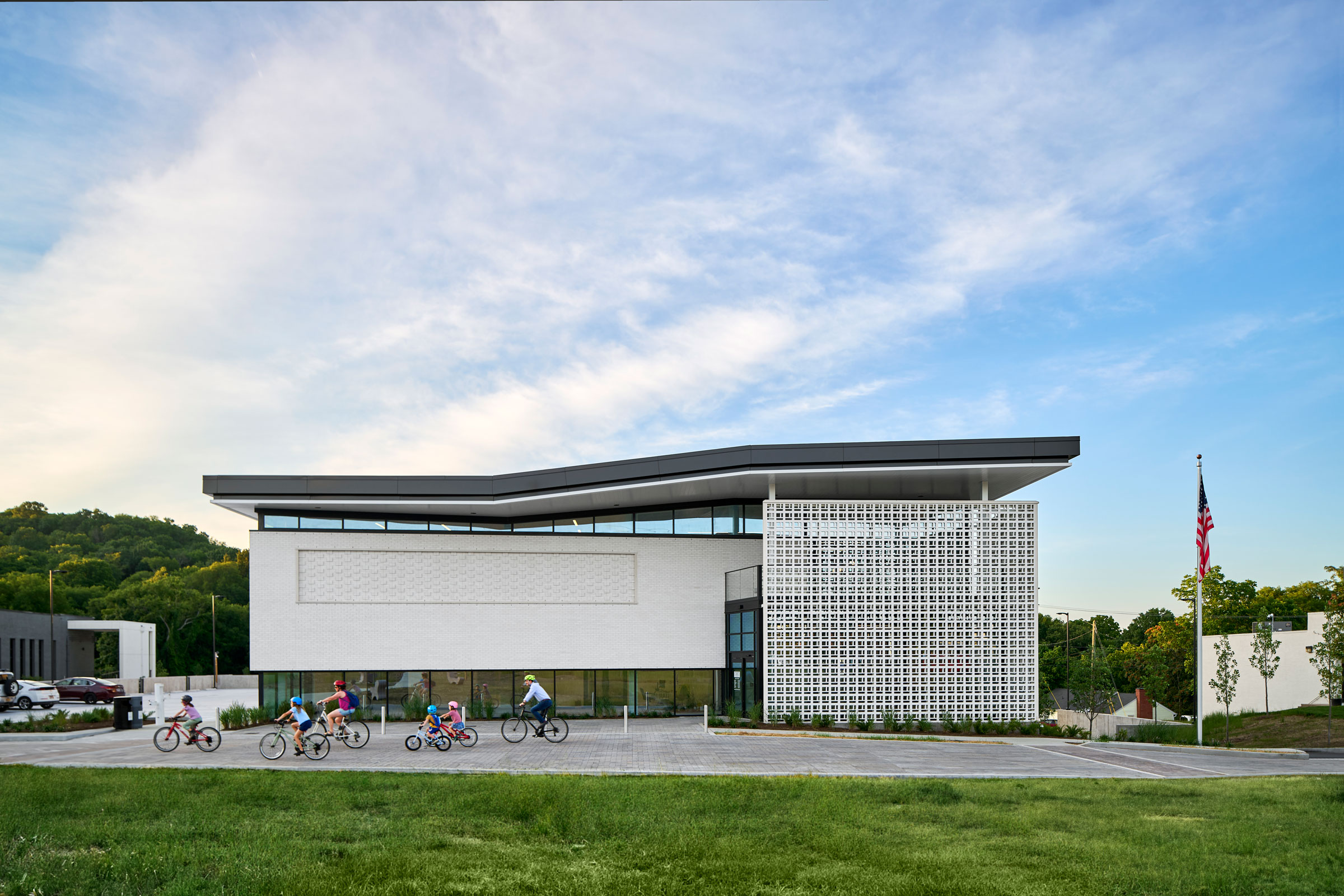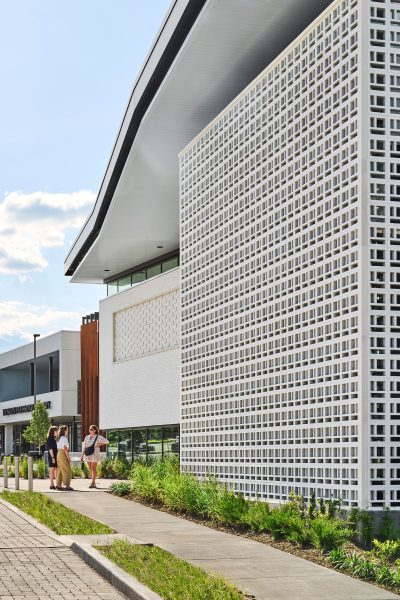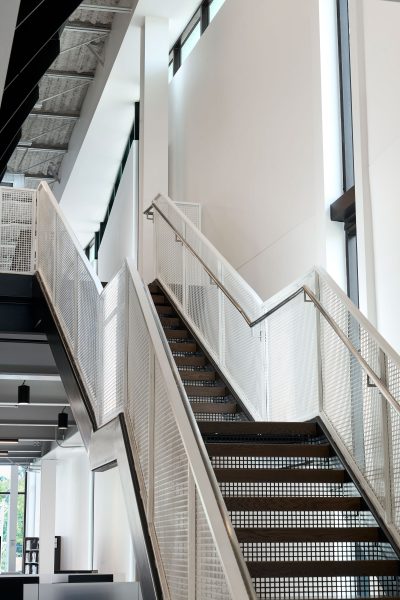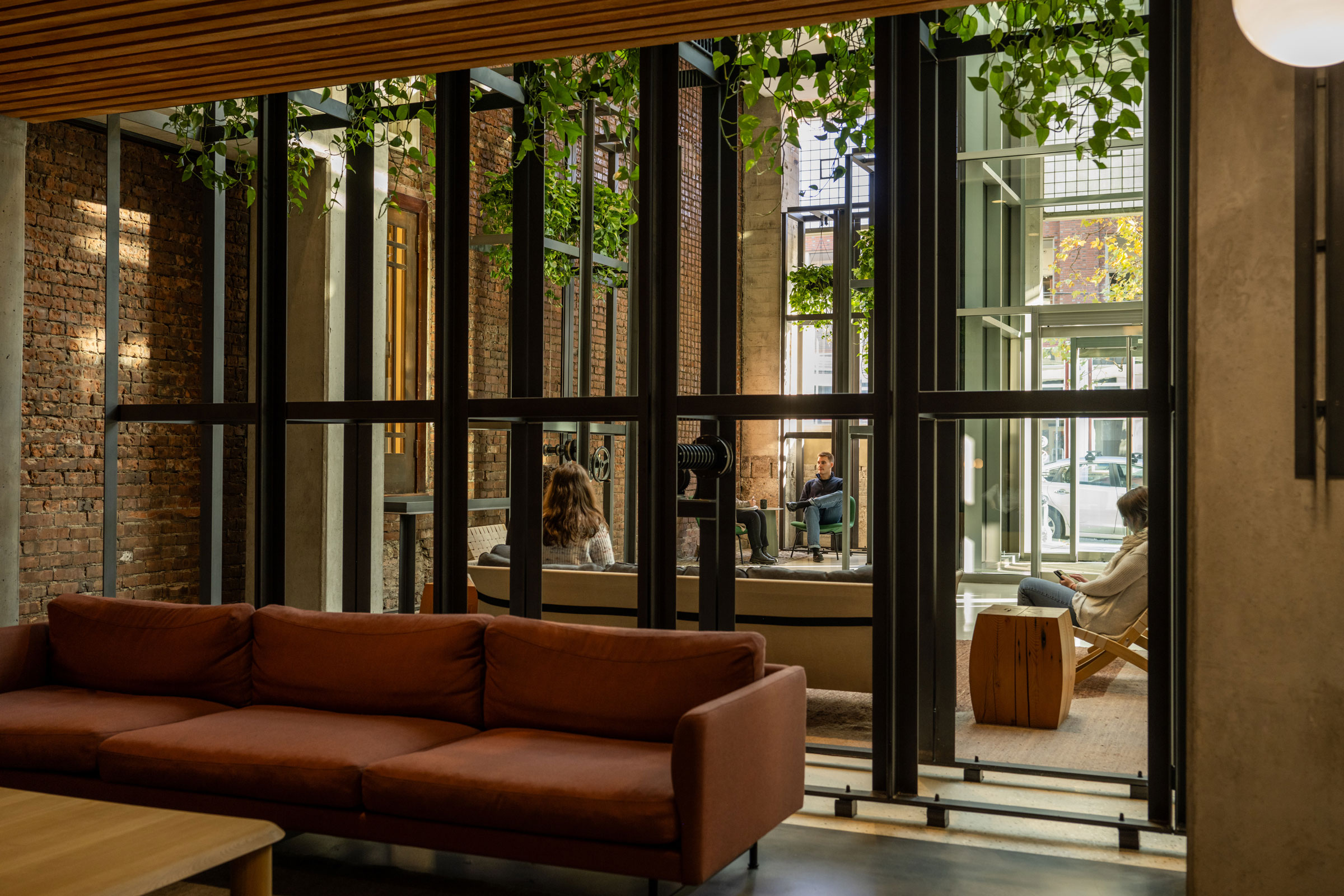Story at a glance:
- Nashville’s booming development and critical climate considerations drove the design of the new Donelson Library.
- The library’s orientation presented challenges but also allowed for energy efficient features like PV arrays and geothermal wells.
- Cement breeze block, a mid-century staple, was used as a modern nod to the neighborhood’s rich heritage.
Many people still love to hold a good, physical book in their hands and go to the library to check out their next read. But these days local libraries are so much more than their book collections. They are a gathering place—a place for communities to access resources, a place for learning and entertainment, a place to meet and exercise civic responsibilities.
“There’s not a typology that has more of an immediate impact on a community than a library and, in particular, a branch library,” says David Powell, principal architect at HASTINGS Architecture, who designed the Donelson Library project. “Libraries are so specific to the community and neighborhood they serve, and that’s a very important part of the character and ethos of HASTINGS as a company.”
The new, LEED Gold Donelson Library is a branch of the Metro Nashville Public Library system, and the mission of this project was multifaceted. It needed to be a welcoming library that served the community with flexible, functional space, and it also needed to be a highly-efficient building with an emphasis on smart design, durability, and longevity.
HASTINGS was also conscious that this new library would be the anchor of the revitalized Donelson Plaza—a 1960s-era shopping center and neighborhood icon. Drawing on the area’s rich history, HASTINGS blended mid-century aesthetics—apparent in the surrounding homes, buildings, graphics, and signage—with modern sustainability-conscious materials and high-performance flexibility.
The Challenges
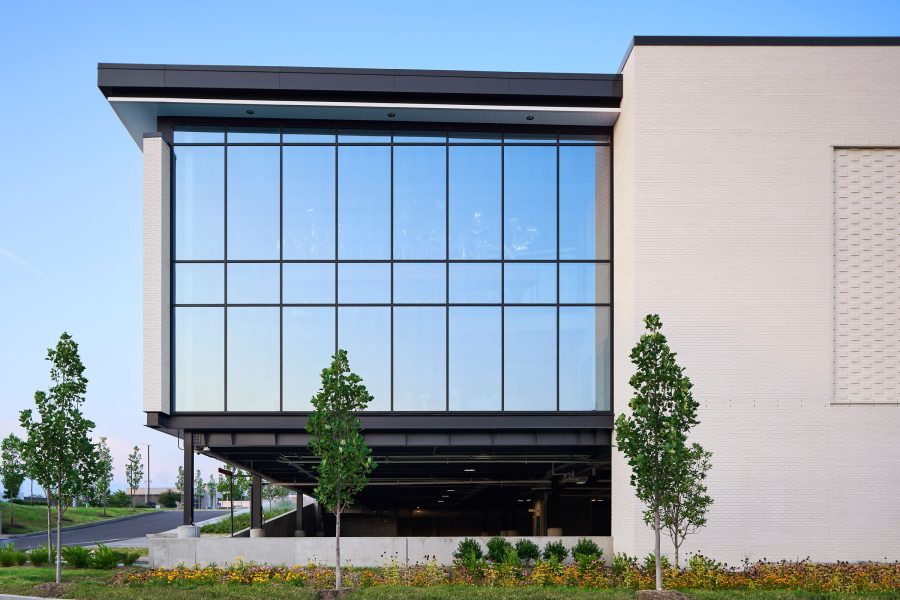
From the beginning HASTINGS knew heat gain was the largest climate challenge from a passive design standpoint at Donelson Library. The designers were strategic about window placement, with an emphasis on how to limit glazing and heat gain but still bring in enough natural light to make the space comfortable for reading and working. With low-E coated glass from Guardian Glass, the building has less than 30% glazing throughout. Photo by Nick McGinn Photography, courtesy of HASTINGS Architecture
Though the building has the advantage of proximity to the Nashville Star, the city’s only pedestrian train, the library’s site orientation presented HASTINGS with its first challenge—welcoming visitors with a traditional, southern “front porch” experience while limiting solar heat gain on the south-facing entry.
“We had to ask ourselves, ‘How do we create this grand, welcoming entry that beckons the community but limits the heat gain being brought into the library?’” says Emilee Wilson Hamm, project manager. “We found a fun way to use breeze block, a mid-century staple, as the first guard on the building front while still interpreting it in a modern way—making it an icon of the community but also shielding that front vestibule entry space.” Even with the breeze blocks visitors can see straight through; they are always connected to nature from inside.
The Solutions
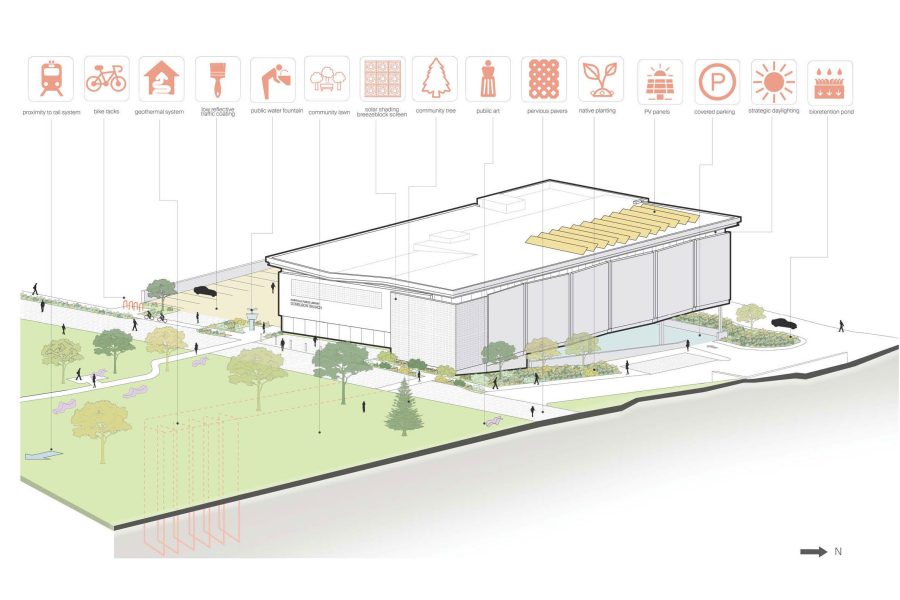
Diagram courtesy of HASTINGS Architecture
Thoughtfully placed windows and limited glazing—of which the building has less than 30%—provide natural lighting for comfortable reading and working. The majority of the glazing is on the north side, where diffused light comes into what feels like a treehouse on the second floor, home to the children’s and young adult collections. On the first floor HASTINGS dropped the height of some windows to reduce glare on future presentations and events that would happen in those spaces.
The two-story clerestory offers a desirable biophilic connection, and the roof overhang with its traditional southern “haint blue” soffit is also strategic in helping protect the interior from direct light, letting in more ambient light. “There’s this great axis happening right where the library lands,” Powell says. “The building is just seven degrees off of a true north-south axis, and, being architects, we love that connection.”
You are always connected to nature when you’re inside the building.
HASTINGS conducted early studies of the sun’s movement onsite to figure out how to passively shade the building, but the library’s exposure to direct sunlight also lent itself nicely to solar power. A rooftop 33.3 kW PV array currently produces about 30% of the building’s total energy throughout the year, with the capacity to increase to 100%, providing passive power and year-round efficiency to the building through a grid-optimized strategy suited to Nashville’s climate.
“Nashville is in a very interesting climate zone,” Powell says. In terms of the International Building Code, the city is in 3A, which is warm and humid. However, there’s a small peak on the climate map where Nashville is that’s right on the border of 4A, a mixed humid zone, which means Nashville can have hot, humid summers and cold, snowy winters. “We have a pretty extreme climate swing. There are about three days of the year where we can actually open our windows, so ventilation strategies are different in Nashville.” This means architects and building designers have to come up with different solutions and rely heavily on various energy sources like geo-exchange.
In the Details
- Donelson Library in Nashville is a nod to the neighborhood’s mid-century heritage. Photo by Nick McGinn Photography, courtesy of HASTINGS Architecture
- Inside the two-story Donelson Library in Nashville. Photo by Nick McGinn Photography, courtesy of HASTINGS Architecture
Donelson Library sits on a topographical grade change from front door to back, so instead of designing a two-story building with an upper floor exposed at the front and the lower floor below grade, HASTINGS created a two-story building as viewed from the front, leaving the back of the building elevated and well above the vulnerable flood field, an increasingly common climate issue in Nashville. This allowed HASTINGS to move library parking below-grade and convert what was a hardscape parking lot into a nearly half-acre front lawn.
HASTINGS put the front lawn to work by installing 30 geothermal wells that plunge 500 feet and use the earth’s temperature to naturally heat and cool the building year-round. “Nashville’s natural climate lends itself really well to how geothermal operates,” Hamm says. Throughout the year water is circulated through pipes back into the building through the below-grade basement, working through water source heat pumps to create hot or cool air to heat and cool the building.
The increased green space with newly planted trees and fewer exposed parking spaces also helps the heat island effect and benefits stormwater management while providing additional programming space and shaded reading areas.
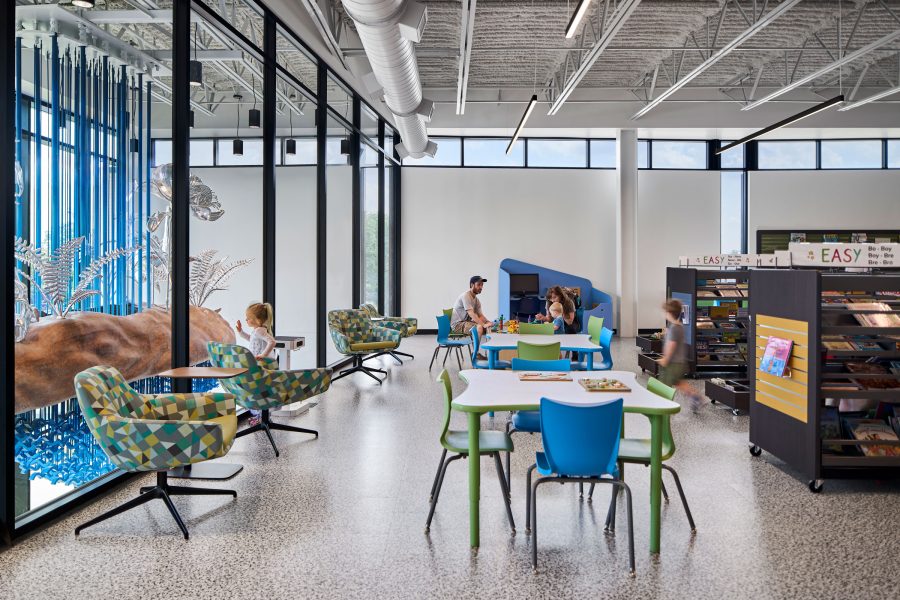
Strategic window placement optimizes natural light throughout Donelson Library. On the second floor, home to the children’s and young adult collections, expansive views of the sky and landscaping create a sensation of being in a treehouse. Photo by Nick McGinn Photography, courtesy of HASTINGS Architecture
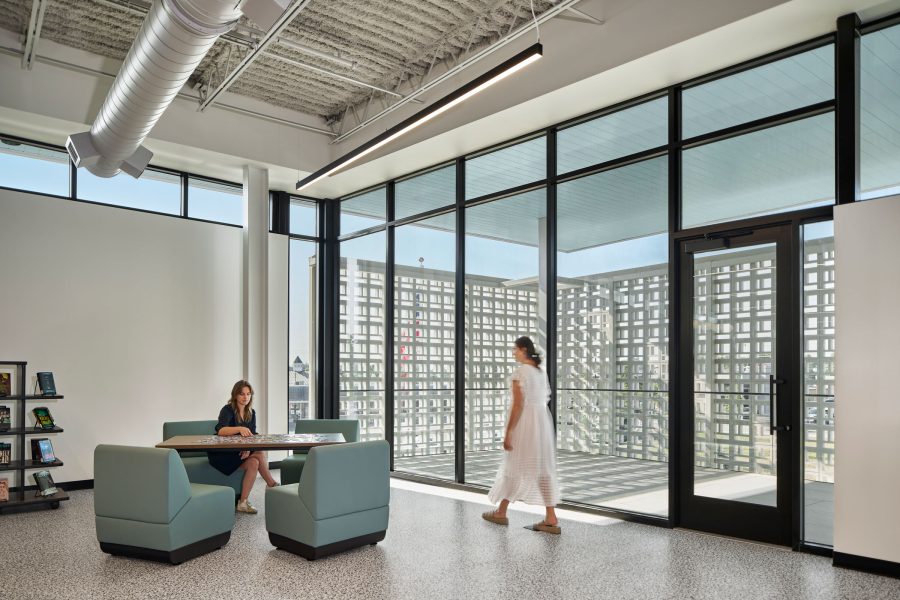
HASTINGS was intentional about every design detail, down to the high-performance luxury vinyl tile (LVT) used throughout Donelson Library’s interior. The GREENGUARD Gold–certified LVT flooring, which mimics natural materials, provides a biophilic design element and is made from recycled content, has a low-carbon footprint, and offers noise reduction. Photo by Nick McGinn Photography, courtesy of HASTINGS Architecture
Sustainability-conscious design choices continue throughout the library’s interior with a material palette that was minimal on purpose, creating ample space for programming while allowing for durability and maintainability for those responsible for daily operations. “The space needed to be beautiful and open and light but also a blank canvas. We knew how much of a collection was coming in and how busy and full the space would be on a daily basis, so we focused on keeping the material palette simple,” Hamm says.
With a consciousness around what visitors and staff would be touching and interacting with each day, HASTINGS analyzed recycled materials on most products. The structural steel framing and interior framing contain recycled content. Low-VOC paints were used throughout the project, as well as LVT floors that mimic natural materials and offer additional benefits like lower cost, improved scratch resistance, and waterproof performance.
“We were inspired by the idea that this building was going to be a landmark of Donelson—a civic center that would be here for years to come,” Hamm says. “But also by how this civic building could be a leader for how good development can be done well.”

